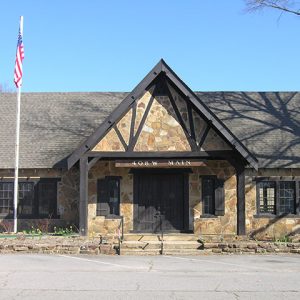calsfoundation@cals.org
Perryville American Legion Building
aka: Doyle-Leach Post American Legion Hut
The Perryville American Legion Building at 408 West Main Street in Perryville (Perry County) is a single-story, Rustic-style structure built in 1933–1934. It was listed on the National Register of Historic Places on September 5, 1990.
Perryville’s American Legion post was named for two Perry County World War I soldiers: Luther Doyle of Aplin (Perry County), who died of pneumonia at age twenty-five on September 14, 1918, and Daniel L. Leach of Houston (Perry County), who served in 164 Company of the Transport Corps and survived the war. In the early 1930s, members of the Doyle-Leach Post sought funding from the federal government for assistance in constructing a building to house their activities. The United States provided $2,500 for the project, with local sources supplying an additional $2,000, primarily in materials.
It is uncertain which one of President Franklin D. Roosevelt’s New Deal agencies provided the funding. The Civil Works Administration (CWA) was instrumental in the construction of legion huts at Eudora (Chicot County), Yellville (Marion County), Des Arc (Prairie County), Augusta (Woodruff County), Knobel (Clay County), Clarksville (Johnson County), and Russellville (Pope County) in 1933 and 1934, so it is likely it was the funding agency. There also was a Civilian Conservation Corps (CCC) camp at nearby Thornburg (Perry County) at the time the Perryville American Legion Building was constructed, so it is also possible the CCC, which was known for its use of Rustic-style architecture, was involved.
In his 1970 memoir Cabin on a Ridge, noted artist and illustrator Howard Simon, who lived with his wife, author Charlie May Simon, near Hollis (Perry County), recalled that a state engineer named Mike Campbell approached him about designing the legion hut and providing a mural for it. Simon, offered thirty dollars a week for the job, accepted, writing that “a half-timber building was indicated in my plan. It was to be of masonry, stone, and heavy oak timbers and was to be built near the courthouse at the county seat. The doors were to be oak, and the ornamentation was to be hammered iron.” He also planned a pair of murals depicting World War I battles, one on land and one at sea, though apparently only one was created, and it is no longer in the building.
The completed Perryville American Legion Building exhibits characteristics of several architectural styles. The prevalent Rustic style is apparent in the use of heavy wood and stone. Exposed rafter tails reflect the Craftsman style, while the Tudor Revival influence is shown in the half-timbering in the gable ends. The most interesting features are the hinges on the front door, which were hand-crafted from the axles of Model-T Fords.
Campbell served as engineer on the project, designing the foundation and the massive wooden interior trusses, of which the National Register nomination states the following: “The most noteworthy [interior] feature is the rough-hewn wood log trusses which support the roof. Typical of the Rustic style, they are only slightly finished and the vertical members have been cut at odd angles to fit together into the carrying beams. Together with the rough-hewn rafters and purlins that support the roof deck they lend and English parish church aspect to the interior.” The interior is also distinguished by a chandelier fashioned from the engine of a Curtiss “Jenny” airplane.
The Perryville American Legion Building was dedicated on July 2, 1934, with around 1,000 people in attendance. District Legion commander W. E. Burns of Little Rock (Pulaski County) presented the keys to Dewey Crowder of the Doyle-Leach Post as post commander H. E. Van Dalsem presided. A dinner followed, featuring speeches by Charles Q. Kelley, who was commander of the Legion’s Arkansas Department, and several others. The evening ended with a dance.
The building served the Doyle-Leach post for many years before becoming Teen Town, a popular gathering place for young people in the mid-twentieth century, and later a restaurant. In 2005, the American Legion’s Department of Arkansas donated the building to the Perry County Historical Museum, which began occupying the space. By 2020, the museum had received grants totaling $67,320 from the Arkansas Historic Preservation Program to help restore the structure.
For additional information:
Hope, Holly. An Ambition to be Preferred: New Deal Recovery Efforts and Architecture in Arkansas, 1933–1943. Little Rock: Arkansas Historic Preservation Program, 2006. Online at http://www.arkansaspreservation.com/News-and-Events/publications (accessed July 14, 2021).
“Perryville’s American Legion Hut Dedicated.” Arkansas Gazette, July 3, 1934, p. 7.
Rolf, Carol. “Museum Works to Preserve Perry County’s Past.” Arkansas Democrat-Gazette, November 17, 2019. Online at https://www.arkansasonline.com/news/2019/nov/17/museum-works-preserve-perry-countys-past/?f=rivervalley (accessed July 14, 2021).
Silva, Rachel. “Walks Through History Perryville Commercial Historic District.” https://arkansaspreservation.worldsecuresystems.com/Learn-More/walks-through-history-archive (accessed July 14, 2021).
Simon, Howard. Cabin on a Ridge. Chicago: Follett Publishing Company, 1970.
Story, Kenneth. “Perryville American Legion Building.” National Register of Historic Places registration form. On file at Arkansas Historic Preservation Program, Little Rock, Arkansas. Online at https://arkansaspreservation.worldsecuresystems.com/National-Register-Listings/PDF/PE0054.nr.pdf (accessed October 2, 2020).
Mark K. Christ
Central Arkansas Library System
 Early Twentieth Century, 1901 through 1940
Early Twentieth Century, 1901 through 1940 Historic Preservation
Historic Preservation American Legion Perryville
American Legion Perryville 



Comments
No comments on this entry yet.